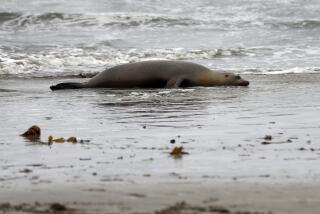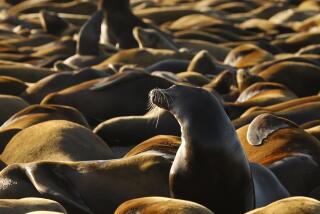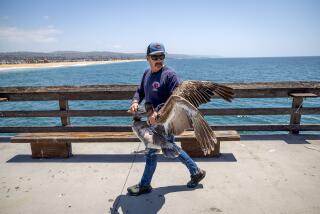Bills of Health : 16 Brown Pelicans Take Wing After Recovering From Botulism
- Share via
SEAL BEACH — With a feathery grace that belied their narrow escape from death, 16 California brown pelicans stricken with botulism at the Salton Sea but nursed back to health in Laguna Niguel were released Thursday into the tranquil waters of the federal wildlife refuge here.
“I feel like a father sending his daughter out on her first date,” said Richard Evans, the Orange County veterinarian and medical director of the nonprofit Pacific Wildlife Project in Laguna Niguel. “We’ve done everything we could to teach them the right thing to do. Now it’s up to them.”
In this case, the right thing is to integrate with the brown pelicans that live at the Seal Beach National Wildlife Refuge and not to return to the Salton Sea, where a botulism outbreak discovered Aug. 15 has killed more than 11,000 birds.
“The brown pelican is very gregarious, and as long as there is sufficient space and enough food, we hope they will not be tempted to fly back to the Salton Sea,” said Brian Collins, a biologist with the U.S. Fish and Wildlife Service.
Evans, who runs the wildlife project with his wife, Linda, hopes to release several hundred more brown pelicans in coming weeks. All were stricken at the Salton Sea.
“I was overcome with how gorgeous they are,” Linda Evans said as several of the newly freed birds spread their wings and flew several hundred yards without apparent effort. Just weeks ago they had arrived in Laguna Niguel by truck in various states of paralysis, dehydration and respiratory distress.
The botulism outbreak has killed birds of 52 different species, but the brown pelican, with its foot-long bill and 6-foot wingspan, has garnered the most attention because of its status as an endangered species.
After the widespread agricultural use of DDT nearly wiped out the brown pelicans, their comeback in the years since the pesticide was banned and habitat areas were protected has been a conservation success story.
But the Salton Sea outbreak has killed an estimated 1,500 brown pelicans, out of the 9,000 to 10,000 living in the wild.
Like other mass bird die-offs at the Salton Sea, the botulism outbreak has proved vexing to scientists. While it has long been known that the botulism bacteria live dormant in the muck on the sea’s bottom, the recent widespread deaths brought a troubling discovery: that avian botulism can exist in live fish, not just the maggots that feed on carcasses and that some birds like to consume.
Scientists had believed that birds that dine on live fish were relatively safe from botulism. Now the fear is sinking in that more birds are vulnerable to the deadly bacterium than previously believed.
“What this has shown us is how little we really know about botulism,” said Susan Saul, spokeswoman for the Fish and Wildlife Service regional office in Portland, Ore.
Many, though not all, of the dead birds have been discovered at the Salton Sea National Wildlife Refuge, a stopping-off point for millions of migratory birds along the Pacific Flyway on the sea’s southeastern shore. Lest the outbreak spread uncontrollably, federal crews have been scooping up carcasses and burning them.
Along with the release in Seal Beach, there was other good news Thursday. The daily death count Wednesday at the Salton Sea was the lowest since the outbreak began, leading to hopes that the worst is over. Healthy brown pelicans also seem to be flying away from that area.
One theory explaining the outbreak holds that the botulism is made actively virulent by a combination of high temperature, wind and the oxygen content of the ever-salty Salton Sea. Just before the outbreak began, the sea experienced high winds, along with its usual triple-digit summer temperature.
So far, with assistance from the Fish and Wildlife Service, more than 700 brown pelicans have been brought to the Pacific Wildlife Project from the Salton Sea, though an estimated 200 of those died en route.
Richard Evans said that 150 brown pelicans are in the project’s hospital and that another 300 are in the recovery area. The plan is to release them all, either in Seal Beach or at the wildlife refuge in Imperial Beach in southern San Diego County.
Surrounded by the Naval Weapons Station, the Seal Beach refuge offers 1,000 acres of protected habitat that has attracted the California least tern, the light-footed clapper rail, the peregrine falcon and other species.
“I feel badly about the 1,500 that didn’t make it,” said Richard Evans. “But at least we’re giving some of the brown pelicans a second chance at life.”
More to Read
Sign up for Essential California
The most important California stories and recommendations in your inbox every morning.
You may occasionally receive promotional content from the Los Angeles Times.










